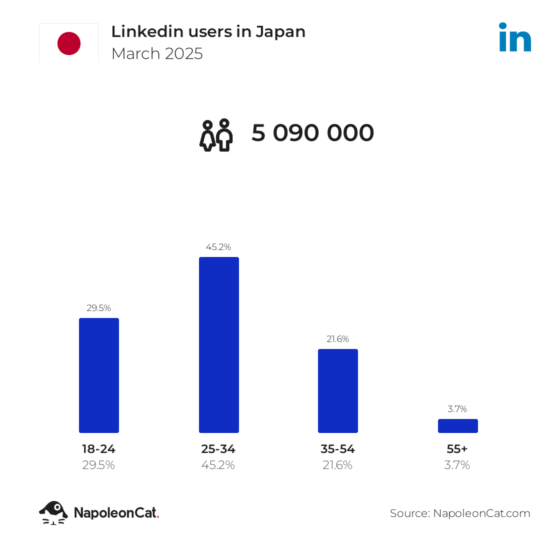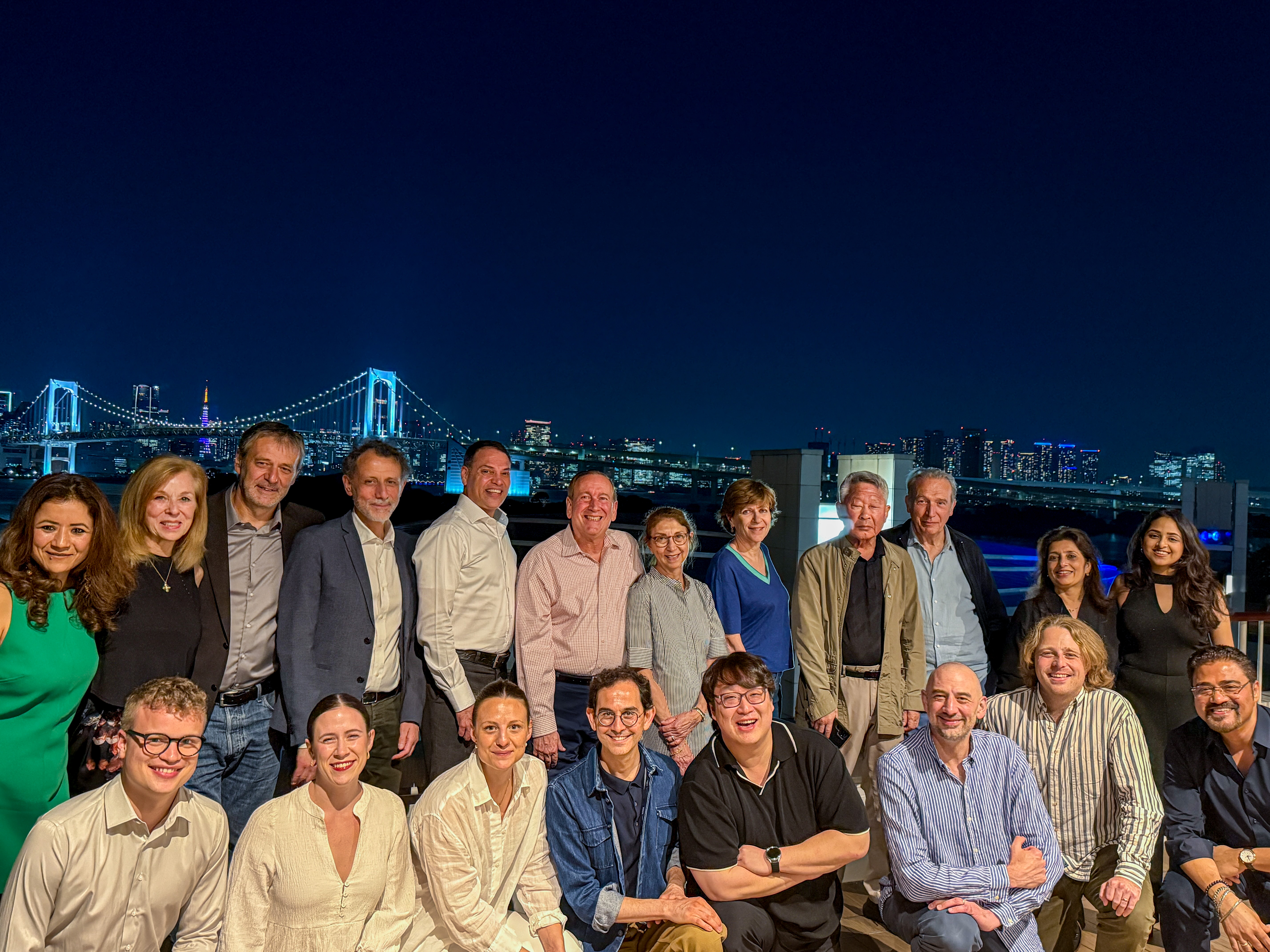
How Can You Achieve B2B Marketing Success on LinkedIn in Japan?
Tapping into the powerhouse of the Japanese B2B market? While LINE remains the dominant social media platform in Japan, there's a valuable opportunity for B2B professionals: LinkedIn.
Often overlooked, LinkedIn boasts a growing user base of engaged professionals, offering a unique gateway to connect with decision-makers.
According to Sprout Social’s 2025 data, 89% of B2B marketers use LinkedIn for lead generation, and 62% say it produces leads for them. Furthermore, LinkedIn accounts for 80% of B2B leads generated through social media.
Imagine being among the pioneers leveraging a platform synonymous with professional networking and career development globally, yet still emerging in Japan. This early adoption can provide a competitive edge, allowing businesses to establish a strong foothold before the platform becomes saturated.
But how do you navigate this platform while being attentive to cultural nuances and maximizing your reach?
This comprehensive guide reveals the secrets of LinkedIn marketing in Japan, providing you with the insights, strategies and tips needed to elevate your brand in the Land of the Rising Sun. Prepare to harness LinkedIn’s potential and conquer the exciting realm of Japanese B2B marketing, driving your business to new heights.
What is LinkedIn Marketing?
LinkedIn marketing is the strategic use of LinkedIn to achieve your professional goals. It involves building your brand or company presence, connecting with potential customers and partners, and establishing yourself as a thought leader in your industry. Through targeted content sharing, strategic networking, and paid advertising options (LinkedIn Ads), you can generate leads, drive website traffic, and ultimately boost your B2B success in Japan.
In 2025, LinkedIn has evolved to become more than just a professional networking platform. It now offers features that support content creators and entrepreneurs, allowing them to build personal brands and connect with audiences in new ways. The platform’s focus on authenticity and relatability has led to an increase in user engagement and a shift towards more genuine, personal interactions. With more than 1 billion users globally, LinkedIn provides a unique opportunity for professionals to establish their presence and influence within their industries.
How Can You Navigate Japan’s Unique Business Culture on LinkedIn?
Japan boasts a thriving economy with a sophisticated and discerning consumer base. For businesses looking to tap into this market, understanding some key cultural aspects can be a game-changer. Here are some features of the Japanese environment that should be taken into account for successful LinkedIn marketing here:
- Brand Reputation is Paramount: Japanese consumers hold brand trust and reputation in high regard. LinkedIn, with its focus on professional credibility and thought leadership, allows businesses to establish themselves as reliable and trustworthy partners.
- Relationship-Driven Culture: Building strong relationships is crucial for success in Japan. LinkedIn’s networking features facilitate fostering connections with potential partners and clients, nurturing long-term business relationships.
- High Expectations for Customer Service: Japanese consumers have high expectations for exceptional customer service. Showcase your commitment to excellent service through informative content that addresses industry pain points and offers valuable solutions.
- Indirect Communication Style: Japanese communication often leans towards indirectness. Avoid overly assertive language in your LinkedIn content. Focus on informative and persuasive messaging that demonstrates expertise without being aggressive.
- Privacy and Politeness Reign: Japanese culture emphasizes privacy and politeness. This translates to a more reserved online presence, with users cautious about sharing personal information and prioritizing respectful online interactions.
By understanding these core values of the Japanese market, you can leverage LinkedIn’s strengths to create a targeted marketing strategy that resonates with the Japanese audience.
Why Should You Use LinkedIn for B2B Marketing In Japan?
Overview of LinkedIn in Japan
While LinkedIn is the dominant professional networking platform globally, its presence in Japan is less widespread compared to other regions. Here’s a breakdown of the platform’s current state in the Japanese market:
- Growing User Base: As of February 2025, LinkedIn had approximately 4.98 million users in Japan, accounting for about 4% of the total population.
- Focus on International Connections: Many current Japanese users are non-Japanese professionals or those with a strong international business focus. Recruiters seeking foreign talent also utilize the platform heavily.
- Early Days for Domestic Adoption: The presence of prominent Japanese business figures like Hiroshi Mikitani (Rakuten CEO) and Kathy Matsui (MPower Partners) on LinkedIn showcases the platform’s potential for domestic users. However, such examples are still exceptions rather than the norm.
Despite the current limitations, there are positive signs:
- Japanese Language Support: The introduction of a Japanese interface has lowered the barrier for entry for domestic users. As familiarity with the platform grows, a potential for increased adoption exists.
- Value for Specific Audiences: For companies targeting international audiences or those seeking highly skilled professionals in Japan, LinkedIn remains a valuable tool for professional networking and brand building.
By understanding the current landscape and its potential for growth, businesses can determine if LinkedIn marketing aligns with their specific goals in the Japanese market.
How Fast Is LinkedIn Growing in Japan and What Does It Mean for Marketers?
While LINE continues to dominate the social media landscape in Japan, LinkedIn is experiencing notable growth among professionals and businesses. As of April 2025, LinkedIn had 5.09 million users in Japan, accounting for 4.1% of the total population.

This marks a significant increase from 4.24 million users in February 2024, representing a growth rate of approximately 20% year-over-year. Such growth indicates a rising awareness among Japanese professionals of the value LinkedIn offers in terms of networking, thought leadership and talent acquisition.
Key Insights:
- User Demographics: The largest user group comprises individuals aged 25 to 34, totaling 2.3 million users.
- Gender Distribution: Approximately 61.3% of LinkedIn’s ad audience in Japan are male, while 38.7% are female.
- Ad Reach: LinkedIn’s advertising tools reached 4.5% of Japan’s internet user base in early 2025.
For businesses looking to tap into the Japanese B2B market, this surge in LinkedIn users presents a golden opportunity. By implementing a strategic and culturally sensitive LinkedIn marketing approach, you can position yourself at the forefront of this rapidly growing market.
What Are the Key Benefits of Using LinkedIn for Marketing in Japan?
Let’s break down some of the main ways your business can benefit from LinkedIn marketing:
1. Targeted Reach
LinkedIn allows for laser-focused targeting capabilities. Reach specific demographics, job titles and companies, ensuring your message reaches the most relevant decision-makers in Japan.
2. Brand Awareness and Thought Leadership
Establish your brand as an industry leader by sharing informative content, participating in discussions and showcasing your expertise. This builds trust and positions your company as a valuable resource.
3. Lead Generation and Sales Pipeline Building
Generate qualified leads through well-crafted LinkedIn campaigns. Connect with potential clients, nurture relationships and convert connections into a strong sales pipeline.
4. Building Relationships
LinkedIn fosters relationship building, a cornerstone of Japanese business culture. Connect with potential partners, engage in industry discussions and build trust through genuine interactions.
5. Access to a Growing User Base
Although LinkedIn is not as popular in Japan as other social media platforms are, its user base is steadily growing. More Japanese professionals are recognizing the platform’s value for career development, networking and business opportunities. By leveraging LinkedIn marketing, you can tap into this expanding audience and grow your influence as the platform continues to gain traction.
6. Advanced Advertising Options
LinkedIn offers sophisticated advertising options that allow for highly targeted campaigns. Features such as Sponsored Content, InMail and Display Ads enable you to reach specific demographics with precision. For Japanese businesses looking to market their products or services to a professional audience, these tools can be incredibly effective in driving engagement and conversions.
By leveraging these benefits, LinkedIn marketing empowers you to connect with the right people in the Japanese market, establish your brand as a leader and achieve your B2B marketing goals.
How Do You Create a LinkedIn Marketing Strategy That Works in Japan?
Crafting a winning LinkedIn marketing strategy for Japan requires a targeted approach that considers both the platform’s functionalities and the specificities of the Japanese market. Here’s a step-by-step guide:
1. Define Your Goals and Target Audience:
- Set SMART Goals: Start by establishing clear, measurable, achievable, relevant and time-bound goals for your LinkedIn marketing efforts in Japan. Are you aiming for brand awareness, lead generation or website traffic?
- Identify Your Ideal Customer Profile (ICP): Who are you trying to reach on LinkedIn in Japan? Research and define your ideal customer profile, considering factors such as industry, job title and decision-making authority.
2. Optimize Your LinkedIn Presence:
- Professional Profile and Company Page: Ensure your personal profile and company page are fully optimized in Japanese. Use relevant keywords in your headline, summary and descriptions.
- Localization: Consider translating key content sections into Japanese to cater to a wider audience.
3. Content Strategy for Engagement:
- Thought Leadership: Establish yourself as a thought leader in your industry by sharing valuable insights, industry trends and original research relevant to your Japanese audience.
- Content Mix: Utilize a variety of content formats to keep your audience engaged, such as long-form articles, infographics, videos with Japanese subtitles and even live Q&A sessions.
- Cultural Nuances: Adapt your content to resonate with Japanese audiences. Focus on informative and persuasive messaging, prioritize high-quality visuals and avoid overly promotional language.
4. Engagement and Community Building:
- Join Relevant Groups: Participate in industry-specific groups on LinkedIn in Japan. Share your expertise, engage in discussions and build relationships with potential customers.
- Network with Influencers: Identify and connect with relevant influencers in your industry on LinkedIn. Collaborate on content or participate in joint discussions to expand your reach.
- Personalized Outreach: Don’t underestimate the power of personalized messages. Reach out to potential customers and partners directly with tailored messages that demonstrate your understanding of their needs.
5. Track and Analyze Results:
- Utilize LinkedIn Analytics: Regularly monitor your LinkedIn analytics to understand what content resonates best with your Japanese audience. Analyze engagement metrics, track website traffic from LinkedIn and adjust your strategy based on the data.
By following these steps and adapting to the cultural landscape, you can build a successful LinkedIn marketing strategy that connects you with your target audience in the thriving Japanese B2B market.
What Are the Best LinkedIn Marketing Tips for Success in Japan?
1. Identify and Understand Your Target Audience
To create an effective LinkedIn marketing strategy, start by thoroughly understanding your target audience. Delve into the demographics, interests and professional needs of your ideal clients or customers. Use LinkedIn’s advanced search features to identify key characteristics of your audience, such as job titles, industries and company sizes. This targeted approach ensures that your content resonates with the right people, making your marketing efforts more impactful.
2. Leverage Social Media Marketing Tools
Enhance your LinkedIn marketing efforts by integrating social media marketing tools. Tools such as Hootsuite, Buffer or Sprout Social can help streamline your content scheduling, monitor engagement and analyze performance. These tools allow you to plan and automate your posts, ensuring a consistent presence on LinkedIn without the need for constant manual updates. Additionally, they provide insights into your audience’s behavior and preferences, helping you refine your strategy.
3. Optimize Your Posting Schedule
Timing is crucial when it comes to maximizing the reach and engagement of your LinkedIn posts. Conduct research to determine the best times to post for your specific audience. Generally, LinkedIn activity peaks during weekday mornings and early afternoons, as professionals are more likely to engage during work hours. Experiment with different posting times and analyze the performance to identify the optimal schedule for your content.
4. Utilize LinkedIn Hashtags Strategically
Hashtags can significantly increase the visibility of your posts on LinkedIn. Use relevant and trending hashtags to reach a broader audience beyond your immediate connections. LinkedIn’s hashtag feature allows users to follow specific topics, making it easier for your content to be discovered by interested professionals. However, avoid overloading your posts with too many hashtags; a few well-chosen ones can be more effective.
4. Track Your Progress with LinkedIn Analytics
Regularly monitoring your LinkedIn performance is essential for refining your marketing strategy. Utilize LinkedIn’s built-in analytics tools to track key metrics such as engagement rates, follower growth and content reach. By analyzing this data, you can identify what works and what doesn’t, allowing you to adjust your approach accordingly. Pay attention to which types of posts generate the most interaction and tailor your content strategy to replicate that success.
5. Conduct Competitor Research
Understanding what your competitors are doing on LinkedIn can provide valuable insights and inspiration for your own strategy. Analyze the profiles, content and engagement tactics of your competitors to identify trends and successful approaches. Look at the types of posts they share, the frequency of their updates and the level of interaction they receive. This research can help you discover new opportunities and avoid potential pitfalls in your LinkedIn marketing efforts.
6. Craft Engaging and Valuable Content
Content is king on LinkedIn. Focus on creating high-quality, valuable content that addresses the needs and interests of your target audience. Share industry insights, thought leadership articles and practical tips that provide real value. Use a mix of formats, including text posts, articles, videos and infographics to keep your content fresh and engaging. Remember, the goal is to establish yourself as a trusted authority in your field.
7. Engage with Your Audience
LinkedIn is not just a platform for broadcasting content; it’s a space for building relationships. Actively engage with your audience by responding to comments, participating in discussions and reaching out to new connections. Personalized interactions can help build trust and foster long-term relationships. Joining and contributing to relevant LinkedIn groups can also expand your network and increase your visibility.
By integrating these tailored tips into your LinkedIn marketing strategy, you can effectively engage with the Japanese market, build a robust professional network and achieve your marketing goals. Remember, success on LinkedIn requires a blend of strategic planning, cultural awareness and continuous learning.
What Can We Learn from LinkedIn Marketing Success Stories in Japan?
Case Study 1: Expanding Horizons: How a US B2B Tech Firm Flourished in Japan with LinkedIn Marketing
Challenge:
A B2B technology company from the United States wanted to expand into the Japanese market and reach Japanese IT decision-makers.
LinkedIn Marketing Strategy:
They created a LinkedIn marketing strategy tailored to the Japanese IT landscape. This included publishing thought leadership content in Japanese, conducting targeted advertising campaigns and engaging with local IT groups and forums.
Results:
Within the first year, the company experienced:
A 200 Percent Increase in Japanese Leads: The targeted approach on LinkedIn led to a significant surge in qualified leads from Japan, indicating strong market interest and engagement.
Partnerships with Major Japanese IT Firms: Leveraging LinkedIn’s networking capabilities, the company successfully forged strategic partnerships with key players in the Japanese IT industry, solidifying its foothold in the market.
Case Study 2: Driving Real Estate Success in Japan
Challenge:
A global real estate agency wanted to establish its presence in the Japanese real estate market and connect with local property buyers and investors.
LinkedIn Marketing Strategy:
They created a LinkedIn strategy that included publishing articles about the Japanese property market, sharing case studies of successful property investments in Japan and connecting with local real estate professionals.
Results:
The implemented LinkedIn marketing efforts yielded impressive results:
Within the first year, the agency experienced a 30 percent increase in their Japanese client base.
The agency successfully secured significant real estate deals in Japan, underscoring the effectiveness of their LinkedIn marketing strategy in achieving business objectives.
Case Study 3: Attracting Japanese Students to an MBA Program in Hong Kong
Challenge:
An MBA school from Hong Kong aimed to attract Japanese students interested in pursuing an MBA in Hong Kong.
LinkedIn Marketing Strategy:
They crafted a LinkedIn campaign targeting Japanese students and parents. They created informative posts on the benefits of an MBA from Hong Kong, shared the success stories of the students and engaged with local education groups.
Results:
The school saw a 40 percent increase in Japanese student inquiries within the first year, and they established a strong presence in the Japanese education market.
Linkedin Marketing FAQs
LinkedIn is not as popular in Japan compared to other social media platforms such as LINE. However, its professional networking features are gaining recognition among Japanese professionals.
LinkedIn provides a platform for targeted B2B and B2C marketing, professional networking and brand building. It allows businesses to reach decision-makers and build relationships based on trust and professionalism.
Understanding Japanese business culture, which values respect, formality and indirect communication is crucial. Marketers should adapt their messaging to emphasize community, quality and long-term relationships.
Begin by optimizing your LinkedIn profile for Japanese audiences, crafting content that resonates with local business values and actively engaging with Japanese LinkedIn users through groups and networking events.
Get Ready to Win at LinkedIn Marketing
Navigating LinkedIn marketing in Japan offers a unique opportunity for forward-thinking businesses to differentiate themselves in a landscape dominated by other social platforms. Despite LinkedIn’s current underutilization in Japan, its potential for professional networking, brand building and targeted marketing cannot be overlooked.
By understanding the cultural nuances of the Japanese market and leveraging LinkedIn’s platform strategically, businesses can establish meaningful connections, build trust and drive growth.
However, you want to make sure you maximize your approach. Want to reach international executives in Tokyo, not only on LinkedIn, but using a variety of creative strategies? Get in touch with us:


